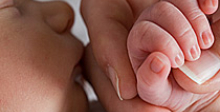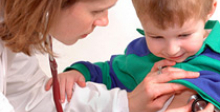Internal mini form
Contact Us Today
Diagnosis is a process that often takes months, not weeks, to determine. Tests, evaluations and assessments also must be completed before a diagnosis is confirmed or ruled out. A diagnosis, however, is a first step in what is likely to be a complex care plan that will play out during a child’s formative years.
Before diagnosis
Diagnosing Cerebral Palsy takes time, and is usually not made until the brain is fully developed when the child is two to five years old. Exceptions exist, usually in severe cases, when the child may be diagnosed soon after birth. The average age of diagnosis for a child with spastic diplegia, a very common form of Cerebral Palsy, is 18 months.
There is no definitive test that confirms or rules out Cerebral Palsy. The baby is monitored for growth indicators, including:
- When does the child reach development milestones?
- How does the child compare to growth chart standards for height and weight?
- How do children’s reflexes react?
- Does it seem as though the child can focus on you or hear you?
- Does posture and movement seem abnormal?
This can be a difficult time for parents who suspect something is different about their child. Often, parents are first to notice their child has missed one of the age-appropriate developmental milestones, like rolling, crawling, sitting and walking.
During diagnosis
The diagnosis process begins by monitoring the child’s development and watching for possible signs of impairment. If a baby is born prematurely, or at a low birth weight, he or she is monitored closely at time of birth in the hospital’s neonatal intensive care unit. If the infant attends regularly scheduled well-baby visits, the pediatrician may be first to notice signs of Cerebral Palsy, such as height, weight, reflex and response. The doctor may even begin to rule out other health conditions.
A pediatric neurologist may perform brain scans such as MRI or CT Scan to detect brain lesions or malformations, which indicate brain damage. During this process, the child’s parent or legal guardian is provided with observations, test results and opinions on diagnosis. When a health care professional provides this information, it is pertinent that parents request a copy of the results for the child’s file. The parent will likely be asked to provide these documents to several other medical providers during the child’s life; having a copy in the child’s home file will save time and money down the road.
When it becomes apparent that the child may have difficulties with muscle coordination, muscle tone, reflexes, posture, balance, fine motor skills, and gross motor skills, then the child will likely be referred to an orthopedic surgeon for evaluation. If the child has problems with breathing, chewing, swallowing, sucking or aspiration, the child will be sent to a speech and language pathologist. Vision and hearing tests are helpful.
Steps involved in the diagnosis process include:
The 12-Step Process of
Diagnosing Cerebral Palsy
- Step 1: Parental Observation
- Step 2: Clinical Observations
- Step 3: Motor Skill Development Analysis
- Step 4: Medical History Review
- Step 5: Documenting Associative Conditions, Co-Mitigating Factors, and Ruling-Out Other Conditions
- Step 6: Obtaining Test Results
- Step 7: Diagnosis
- Step 8: Obtaining Second Opinions
- Step 9: Determining Cause
- Step 10: Care Team Assembly
- Step 11: Care Plan Creation
- Step 12: Embracing a Life with Cerebral Palsy
Though there are no tests to definitively diagnose Cerebral Palsy, information on helpful screens, tests and evaluations include:
Screens, Tests and Evaluations for Cerebral Palsy:
After diagnosis
Once confirmed, the diagnosis allows the parents to better understand the child’s health status, remove doubt and anxiety, begin treatment, and secure benefits to offset the cost of raising a child with Cerebral Palsy.
A Cerebral Palsy diagnosis can be overwhelming as a parent begins to realize his or her child has a physical impairment that cannot be cured, but can be managed. Often, parents retain only a portion of information initially presented by doctors and other medical practitioners.
As the child grows, parents will meet with school administrators, physical therapists, adaptive equipment specialists, home care providers and others. In initial consults, the parent will be asked about the cause, type, and form of Cerebral Palsy their child has. Some medical specialists find it helpful to know the extent, location, and severity of the child’s impairment. The industry may use various common medical terms to define various aspects of the child’s impairment. Although health care providers will likely confirm diagnosis with the child’s primary care physician before formally treating the child, a parent may nonetheless benefit from a document that will document findings and test results.
The MyChild™ Diagnosis Checklist is designed by MyChild™ to provide a parent with better understanding and an easy-to-use checklist to document a child’s condition as provided by health care providers. Over the course of the child’s lifetime, it is likely a parent will need to provide this information to many individuals caring for the child. The information can be easily stored in the child’s home medical records.
For your copy of the MyChild™ Diagnosis Checklist:
Documenting diagnosis for care plan
The following information obtained during diagnosis will prove valuable in the months to years following, when talking to professionals for their expertise, to qualify for benefits, and to document care. These will be needed to assist in understanding, explaining, and managing the child’s health conditions.
Document cause of Cerebral Palsy
- Radiological findings of brain injury or abnormality – PVL, IVH, HIE, Cerebral Dysgenesis
- Cause of brain damage or abnormality – prematurity, low birth weight, asphyxiation, shaken baby, accident
- Timing of brain damage – prenatal, perinatal, postnatal, acquired, congenital, or genetic predisposition
Document form of Cerebral Palsy
- Severity – mild, moderate, severe, and no CP
- Extent – plegia or paresis
- Location/anatomical distribution – mono, di, hemi, para, tri, tetra, quad, and penta
- Gross Motor Function Classification Level – Level I, Level II, Level III, and Level IV
Obtain medical records
During the diagnosis process many screens and tests may provide relevant information to confirm or rule-out a diagnosis of Cerebral Palsy. For efficient retrieval, these should be stored in a child’s home medical record file. They will be needed for visits with other medical practitioners, for qualifying for government benefits and for contracting professional services.

Diagnosis of Cerebral Palsy
Parents are often disheartened to learn that there is no singular test that will accurately diagnose a child with Cerebral Palsy. Once a round of medical evaluations are initiated in order to form a diagnosis, parents prepare for a long and sometimes frustrating process that will, in time, provide answers about a child’s condition.
Diagnosis of Cerebral Palsy









